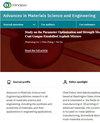以PMMA微球为模板制备具有连通空间的高孔铝基陶瓷
4区 材料科学
Q2 Engineering
引用次数: 11
摘要
采用不同直径的聚甲基丙烯酸甲酯(PMMA)微球为模板,氧化镁或碳化硅粉末为助烧结剂,在1600°C下煅烧,采用滑移铸造法制备了多孔氧化铝基陶瓷。可以制备反映PMMA微球形貌的球形孔。此外,在所有陶瓷的孔隙内壁上,观察到孔隙之间形成了更小的连接空间。在这种方法中,可以通过改变PMMA微球的粒径及其在氧化铝基浆料中的浓度来控制孔隙结构,例如孔径、形状(开放或关闭)和力学性能。采用平均粒径为22.6𝜇m的PMMA微球和适量的SiC,可制得孔隙率为62%、连通空间尺寸为1.3𝜇m、抗压强度为147.6 MPa的高孔隙度、机械强度高的氧化铝基陶瓷。本文章由计算机程序翻译,如有差异,请以英文原文为准。
Fabrication of Highly Porous Alumina-Based Ceramics with Connected Spaces by Employing PMMA Microspheres as a Template
Highly porous alumina-based ceramics were fabricated by a slip casting method by employing polymethylmethacrylate (PMMA) microspheres having different diameters as a template and MgO or SiC powder as a sintering aid and subsequent calcination at 1600∘C. Spherical pores reflecting the morphology of the PMMA microspheres could be fabricated. In addition, the formation of much smaller connected space among the pores was observed on the pore's inner walls of all ceramics. In this method, porous structure, for example, pore diameter, shape (open or closed), and mechanical properties, could be controlled by varying the particle size of PMMA microspheres and its concentration in alumina-based slurries. Highly porous and mechanically strong alumina-based ceramics having an open porosity of 62%, a connected space size of 1.3 𝜇m, and a compressive strength of 147.6 MPa could be fabricated by employing PMMA microspheres with a mean particle size of 22.6 𝜇m and an appropriate amount of SiC.
求助全文
通过发布文献求助,成功后即可免费获取论文全文。
去求助
来源期刊

Advances in Materials Science and Engineering
Materials Science-General Materials Science
CiteScore
3.30
自引率
0.00%
发文量
0
审稿时长
4-8 weeks
期刊介绍:
Advances in Materials Science and Engineering is a broad scope journal that publishes articles in all areas of materials science and engineering including, but not limited to:
-Chemistry and fundamental properties of matter
-Material synthesis, fabrication, manufacture, and processing
-Magnetic, electrical, thermal, and optical properties of materials
-Strength, durability, and mechanical behaviour of materials
-Consideration of materials in structural design, modelling, and engineering
-Green and renewable materials, and consideration of materials’ life cycles
-Materials in specialist applications (such as medicine, energy, aerospace, and nanotechnology)
 求助内容:
求助内容: 应助结果提醒方式:
应助结果提醒方式:


